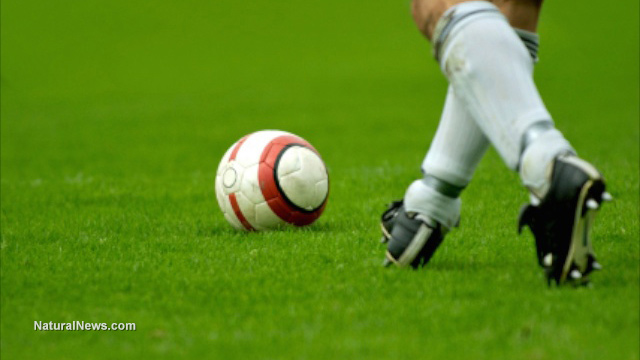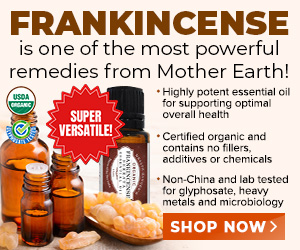Is artificial turf giving children cancer?
Wednesday, February 17, 2016 by: PF Louis
Tags: artificial turf, cancer, child athletes

(NaturalNews) Seattle soccer coach Amy Griffin was puzzled by the sudden rise in young girls who played soccer coming down with cancer, usually blood cancers like lymphoma and leukemia. "I've coached for 26, 27 years," claimed Amy. "My first 15 years, I never heard anything about this. All of a sudden it seems to be a stream of kids."
These cancer victims were all in their teens when stricken. Whatever other possible various carcinogenic intrusions and poor nutritional diets had to do with their early onset cancers, there was one constant: artificial turf playing fields.
After discovering a few soccer-playing cancer victims in Seattle, Amy scoured the country and discovered 38 cases of young teens who were soccer players, 34 of them goalies, that had been stricken with cancer. Her list has been growing, with parents emailing her about their soccer-cancer kids. But why more goalies than others?
Well, that they eat more dirt diving for balls is a starter. But on artificial turf fields, they're eating tiny pellets of rubber from crushed vehicle tires instead of dirt.
These pellets ware placed as a layer in the chemically produced grass blades to cushion falls after complaints of artificial turf's hardness. Those pellets get into their mouths, their hair and their clothing.
So where's the cancer coming from?
Those little rubber pellets have been analyzed for carcinogens, and some measurements have been taken on the VOCs (Volatile Organic Compounds) that off-gas from the pellets when artificial turf fields get hot. These fields generally run at temperatures 15 degrees hotter than ambient air.This increases the off-gassing of VOCs such as benzene, methylene chloride and various polycyclic aromatic hydrocarbons (PAHs).
The pellets themselves contain mercury, cadmium, arsenic and lead. All the trade groups associated with the artificial turf industry, such as the Synthetic Turf Council, maintain that there are no problems or carcinogenic connections to be concerned about, and of course they have tests to prove it.
But here's one dissenting voice, Dr. Joel Forman, associate professor of pediatrics and preventive medicine at New York's Mt. Sinai Hospital:
"None of [the studies] are long term, they rarely involve very young children and they only look for concentrations of chemicals and compare it to some sort of standard for what's considered acceptable," said Dr. Forman.
"That doesn't really take into account subclinical effects, long-term effects, the developing brain and developing kids. ... [E]ven... chronic lower exposures" could lead to inconspicuous neurodevelopmental problems in children. "Those are always suspect," he added.
The usual standards of laboratory analysis are lower when the profiting industry funds those reports. But few challenge them even if they have the power. The EPA refuses proper long-term testing and calls it a state- or local-level issue.
Artificial vs. real turf
In 2008, the NFL conducted a survey among players regarding their thoughts on artificial turf. Almost all of them agreed, 84% in one category and 92% in the other two categories, respectively, that they endured more injuries and post-game soreness, and that playing on artificial turf was shortening their careers.The artificial grass industry has used the carbon card. They claim that motorized lawn mowers create more carbon. But they ignore how large patches of real grass sucks up more CO2 than those mowers can put out.
Industry folks also claim that better traction helps keep injuries down. But others point out how that surface stickiness can grab on to cleats, leading to twisted knees and ankles while maneuvering rapidly.
If you're involved with a group pondering the financial merits of installing artificial turf, Red Hen Turf offers a basic PDF guide for those who are considering such a plan.
They do cost analysis and explain the features, merits and demerits of different turf choices without bias. You can access that pdf guide here.[PDf]
Sources for this article include:
http://www.nbcnews.com
http://www.ehhi.org
http://www.syntheticturfcouncil.org
http://www.redhenturf.com[PDf]
Artificial turf at FETCH.news
Get independent news alerts on natural cures, food lab tests, cannabis medicine, science, robotics, drones, privacy and more.
Take Action: Support Natural News by linking to this article from your website
Permalink to this article:
Embed article link: (copy HTML code below):
Reprinting this article:
Non-commercial use OK, cite NaturalNews.com with clickable link.
Follow Natural News on Facebook, Twitter, Google Plus, and Pinterest
- Newly released JFK files reveal Pentagon's role in creating Lyme disease and covid in the same lab
- The hidden dangers in your kitchen: How cooking methods impact diabetes, cancer and aging
- DEADLY DECEPTION: How COVID vaccines increased mortality rates and why authorities hid the truth
- CDC finally halts $11 billion COVID funding scam as health officials admit the ‘pandemic’ was a fraud
- Arkansas embraces medical freedom with landmark ivermectin law
- GAIN-OF-FUNCTION CAT-BIRD-FLU now on the rise as nearly a dozen cats in Colorado "test positive" for Bird Flu due to contaminated cat food
- Lab leak confirmed? Boris Johnson's stunning reversal on COVID origins sparks global debate
- Home gardening for preppers: A beginner's guide to growing your own food
- Unraveling the paradox: Why intelligent individuals fall prey to everyday blunders
- Cartels shift tactics: Kidnappings and organ trafficking surge as border crossings plummet under Trump policies
- Why you should think twice before buying mainstream toothpaste formulas
- Trump's greatest betrayal so far: Accelerating Middle East wars, silencing dissent, and serving Zionist masters
- Was JFK's assassination orchestrated by a CIA double agent? New evidence points to James Angleton as the “architect”
- Key nodes of Federal Government censorship
- ATTENTION PRESIDENT TRUMP: Please WITHDRAW your nomination of Dr. Susan Monarez for CDC Director as she is a VAX FANATIC and TOXIC JAB ZEALOT
- “Rent-a-womb” scandal: How China is exploiting U.S. birthright citizenship for long-term espionage
- Record honeybee deaths devastate U.S. agriculture, pesticides under scrutiny
- Speaker Johnson warns Congress may defund or disband rogue courts targeting Trump
- Newly released JFK files reveal Pentagon's role in creating Lyme disease and covid in the same lab
- Elon Musk: Aliens could be here on Earth RIGHT NOW
- Festive flavors: The sweet history, nutritional profile and health benefits of pecan pie
- Trump reverses course on Gaza plan, says “nobody is expelling Palestinians”
- Reclaim your health: How midlife exercise reverses years of inactivity
- Big Pharma's $8 Billion bribery scheme exposed: how doctors are pushed to prescribe junk science, not heal
- Boys are back in town: Trump’s patriotic alpha crew takes the wheel while toxic females ride in the backseat
- EPA advisor admits the agency is funneling billions to climate groups ahead of Trump’s return to White House
- Space war brewing? Russia threatens to destroy Starlink satellites
- Survival 101: Effective EMF blocking techniques
- A lack of integrity in Academia: Harvard professor found GUILTY of fraudulent research to promote CRT theory
- Mike Adams Sermon 66: God will DESTROY ISRAEL for its wickedness
- 5 Simple steps to boost your brainpower: How to strengthen executive function in a distracted world
- Rep. Nancy Mace introduces bill to ban biological males from female facilities on federal property
- Sugarcane extract superior to cholesterol-lowering drugs?
- WHO focusing more on policing speech about public health and implementing global surveillance systems
- Pilots report mysterious lights 'moving at extreme speeds' across Oregon skies
- Dr. Mike Yeadon releases 15-minute testimony - WATCH - about genocidal intent of COVID “vaccines”
- EPA advisor admits the agency is funneling billions to climate groups ahead of Trump’s return to White House
- The Health Ranger releases “Vaccine Zombie” song and music video, using AI-animated zombies for the music video
- California's social media censorship law struck down: A victory for free speech or a threat to online safety?
- Dr. Mike Yeadon releases 15-minute testimony - WATCH - about genocidal intent of COVID “vaccines”
- The pandemic as a tool for INDOCTRINATION: Understanding “The Indoctrinated Brain” by Dr. Michael Nehls
- Florida takes a stand: DeSantis proposes permanent ban on mRNA vaccine mandates
- Mike Adams releases country western hit single: Goin’ Back in Time is Comin’ Home
- Mike Adams releases music poetry sensation: A Child of God
- “Why we influenced the 2020 elections”: Facebook files reveal the coordinated effort to bury the Hunter Biden laptop story
- RFK Jr. clears key hurdle: Sen. Susan Collins backs controversial HHS nominee, signaling a new era for health policy
- Unpacking the Lies That We’ve Been Fed – new song and music video released by Mike Adams, the Health Ranger
- Mike Adams releases new song and music video: Nothing More Disgusting Than a Globalist
- Newly released JFK files reveal Pentagon's role in creating Lyme disease and covid in the same lab
- Congratulations to the FULLY UNVACCINATED as you resisted the COVID-19 PROPAGANDA MACHINE fueled by over $100 BILLION
- Michigan sheriff announces criminal investigation into 2020 election crimes, Dominion Voting Systems
- Israeli soldiers accused of even more torture and abuse in the West Bank
- Migrants are taking advantage of recent hurricanes to scam residents and loot their homes
- House Intelligence Committee calls for the ARREST and PROSECUTION of Dr. Anthony Fauci
- Red Cross issues warning to stop blood plasma donations from vaccinated people
- Scientists confirm: GENIUS brain function can be spontaneously unleashed in humans without any apparent cause
- EPA advisor admits the agency is funneling billions to climate groups ahead of Trump’s return to White House
- HYSSOP: What research reveals about the health benefits of this ancient holy herb
- Two containers with completed ballots fall out of truck in Florida
- Fully vaccinated about to see “tsunami” of illness and death, warns virologist
- Global leaders unite to clamp down on “misinformation” with UN-backed Cascais Declaration
- BREAKING: 2025 NDAA authorizes mandatory military draft of WOMEN across America… as Pentagon pursues global NUCLEAR war with both Russia and China at the same time
- Michael Yon warns of a ZIONIST TAKEOVER in Trump’s second administration
- BOMBSHELL: DNA testing kits are a SCAM to develop ethnic-specific bioweapons
- Ozempic and Wegovy weight loss drugs are injectable LIZARD VENOM PEPTIDES that may unleash a devastating wave of organ failure… side effects align with symptoms of SNAKE BITES
- Israeli soldiers accused of even more torture and abuse in the West Bank
- These 13 countries just signed an agreement to engineer a global FAMINE by destroying food supply
- NASA admits that climate change occurs because of changes in Earth’s solar orbit, and NOT because of SUVs and fossil fuels
- RFK Jr. clears key hurdle: Sen. Susan Collins backs controversial HHS nominee, signaling a new era for health policy
- Sermon 30: How Jesus reveals Caesar’s FAKE CURRENCY and FALSE AUTHORITY
- Coriander seeds: Ancient medicine backed by modern science
- Arizona officials claim Maricopa County needs 10-13 days to tabulate results of the election
Science News & Studies
Medicine News and Information
Food News & Studies
Health News & Studies
Herbs News & Information
Pollution News & Studies
Cancer News & Studies
Climate News & Studies
Survival News & Information
Gear News & Information
News covering technology, stocks, hackers, and more



"Big Tech and mainstream media are constantly trying to silence the independent voices that dare to bring you the truth about toxic food ingredients, dangerous medications and the failed, fraudulent science of the profit-driven medical establishment.
Email is one of the best ways to make sure you stay informed, without the censorship of the tech giants (Google, Apple, Facebook, Twitter, YouTube, etc.). Stay informed and you'll even likely learn information that may help save your own life."
–The Health Ranger, Mike Adams












































